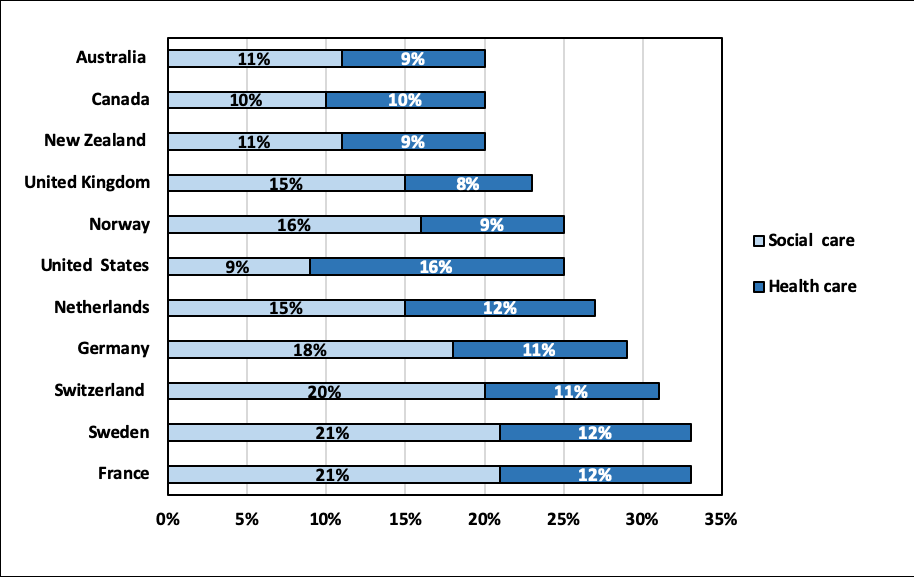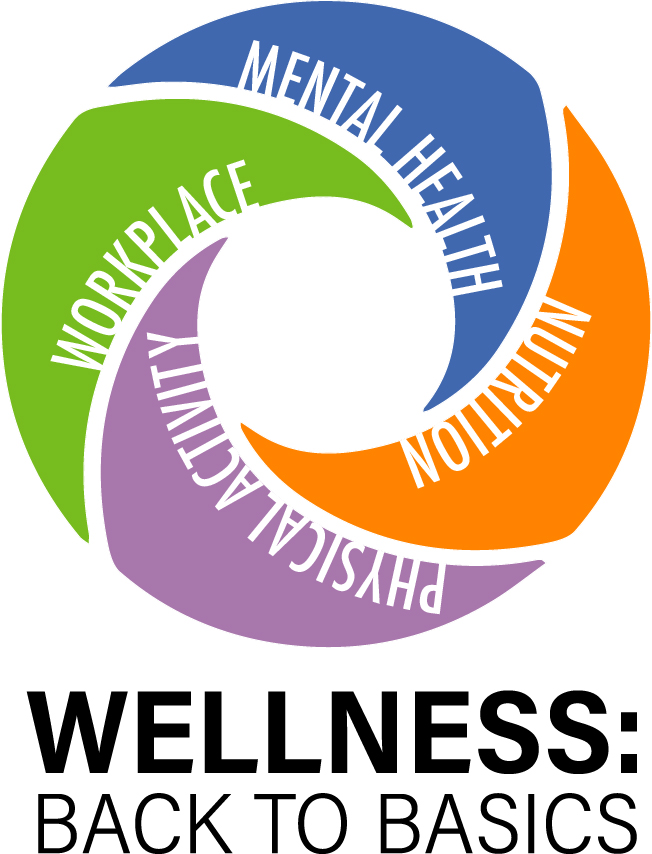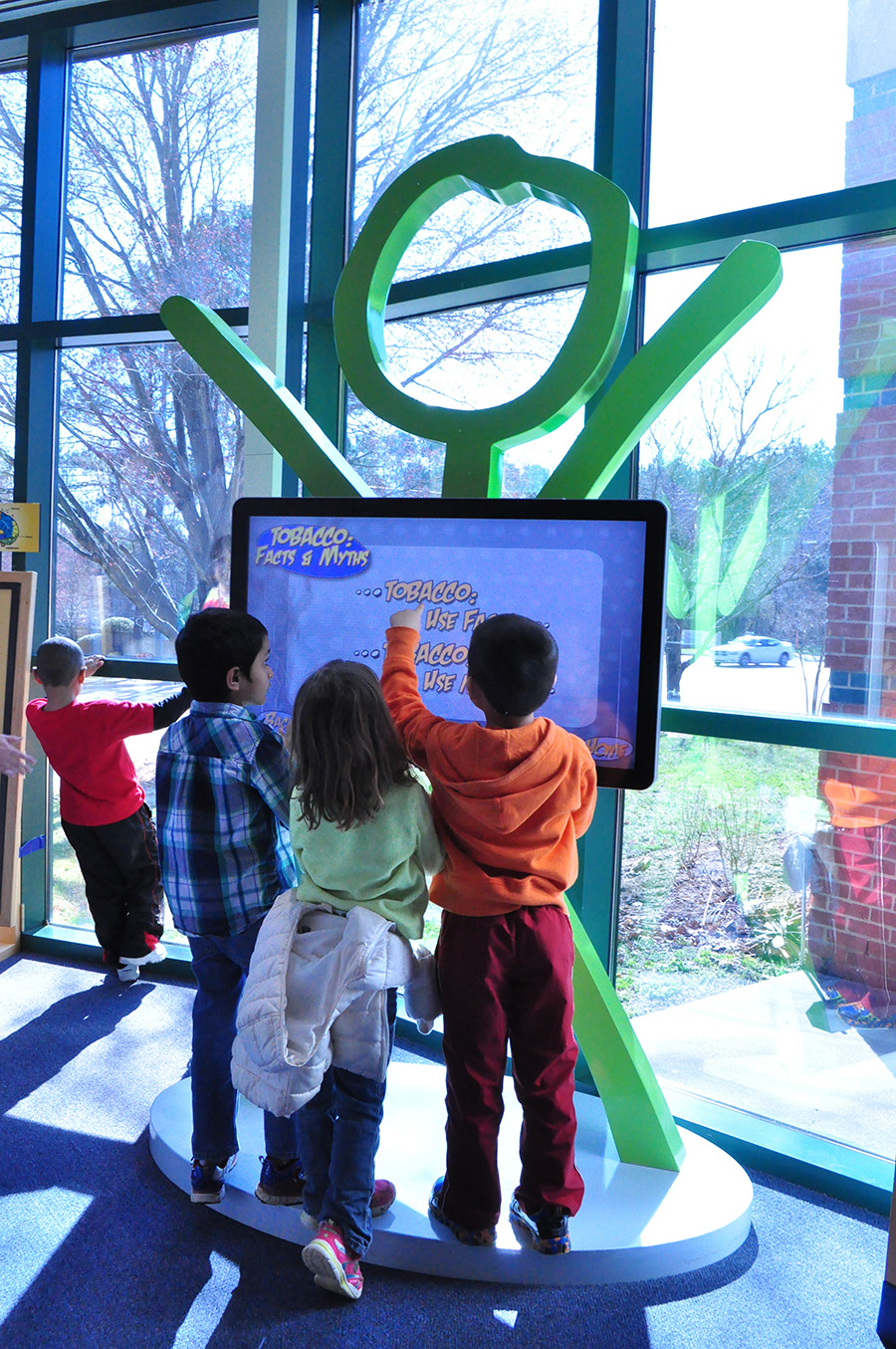Working Upstream: Accountable Care Communities
Working Upstream: Accountable Care Communities
Adam Zolotor, MD, DrPH
President and CEO, North Carolina Institute of Medicine
It is clear that health care in the US is the most expensive in the world. We spend nearly twice the percent of our GDP on health care as other industrialized nations---currently at 17.9% of the GDP and climbing steadily to a projected 19.9% of the GDP by 2025. And for all of that investment, we have some of the poorest health with lower life expectancy and higher rates of infant mortality, cancer, heart disease, obesity, and people with two or more chronic conditions than most industrialized nations. One reason is that our system is designed to care for sickness rather than wellness. We spend about twice as much on health care as we do on social care, a ratio that is flipped in most other developed countries (see figure).
Figure: Spending on Health and Social Care as Percentage of Gross Domestic Product in Select High-Income Countries

North Carolina is moving rapidly from a health care system where fees are paid by insurers to providers for services and procedures (office visits, surgeries, etc.) to a system where fees are paid for delivering on wellness. This is known as fee-for-value care and represents a fundamental shift in payment for health care. Between Medicaid transformation and rapid movement in private insurance (Medicare and non-Medicare), we expect that as many as 40% of North Carolinians will have health insurance in a value-based arrangement in the next two years.
This is an incredible opportunity for health systems and communities to re-imagine what we value and why. Health systems will need to deliver on healthy communities and will be paid based on health rather than on procedures. They will need to partner with the communities they serve to identify and pay for appropriate resources (food, housing, transportation, violence prevention, childcare, employment, etc.)
The North Carolina Institute of Medicine convened a task force to develop a model known as Accountable Care Communities (ACCs) in NC (also known as Accountable Communities for Health, Accountable Health Communities, and other names). ACCs are coalitions of cross-sector stakeholders, including health care providers and community agencies that work together to improve health in a community. ACCs integrate health care, public health, education, and social services to address multiple determinants of health, including social determinants. The development of these models is happening alongside the transition to value-based payment systems that put a focus on patient outcomes rather than the amount of health care services provided. An ACC requires a true partnership between human service organizations and health systems with shared risk, shared reward, and shared governance.
Core features of an ACC include:
- Assessment of community health
- Education and advocacy
- Screening tool
- Referral process
- Navigation services
- Tracking system
- Outcomes data and analysis
- Financing plan
- Governance plan
The NC DHHS Healthy Opportunities portfolio and much of the work of county health departments will address many of the core features of an ACC. Many health systems in NC have begun to work with communities to develop some of the features of an ACC and many community coalitions in the state are working toward these goals as well. The ACC model is an ambitious and optimistic set of strategies that are being used to improve the health of communities across the country. These strategies represent a way of thinking about the role of community partnerships in developing a system for health—not sickness.
Dr. Adam Zolotor is the President and CEO of the North Carolina Institute of Medicine and an associate professor of Family Medicine at the University of North Carolina School of Medicine. He is the featured keynote speaker at the Poe Center's 2019 annual meeting and conferences, WELLNESS: Back to basics.
Featured Poe Event: Wellness: Back to Basics - The Poe Center's Annual Meeting and Conferences
Date: September 9th-11th, 2019
Time: See event for details

The Poe Center’s 2019 Annual Meeting and Conferences will examine wellness and will focus on the essentials for good living. This three-day event will feature a VIP Event at the Poe Center, a breakfast at WakeMed's Andrews Center in Raleigh, and a luncheon and panel discussion hosted by the Greensboro College Department of Kinesiology at Mane Stage conference room at Reynolds Family Student Life Center in Greensboro.
Dr. Adam J. Zolotor, President and CEO of The North Carolina Institute of Medicine, Professor of Family Medicine at the University of North Carolina, and this month's Poe blog contributor will be the featured keynote speaker in Raleigh and Greensboro.
These events will highlight healthy habits and how we can improve individual and community well-being.
Featured Crio Lesson: Stress - How to Deal
Grade Level: K- 5th grade | Program Length: 15-45 min

The Poe Center has partnered with SAS through Curriculum Pathways to provide online access to health science and health education lessons at no cost to teachers across the State of North Carolina. Designed to complement its health education curriculum, the Poe Center’s programs and online content are aligned with the North Carolina Department of Public Instruction’s Healthful Living and Science Essential Standards.
This lesson will describe what stress is, when we might experience stress, and ways we can manage stress including yoga, meditation, and deep breathing exercises. Appropriate for 4-5th grades as a supplemental activity to Decisions...Decisions...
Sex Education in North Carolina: The Basic Facts
Sex Education in North Carolina: The Basic Facts
Robin Pittman, MS, CHES
Senior Health Educator
“Isn’t my child too young to learn about periods?” “What if I don’t feel comfortable with what you’re teaching?” “Are you going to teach them about sexual intercourse?” “Do they have to attend the sex-ed class?”
As a health educator for over 20 years, these are some of the common questions and concerns parents express to me when it comes to sexuality education classes taught in North Carolina. Thanks to the partnership the Poe Center has with the NC Department of Public Instruction and role with school systems across NC, I am in a position to reassure them that the sexual health programs schools use have very positive results for youth.
We know that adolescents who participate in comprehensive sexuality-education programs have lower rates of unintended pregnancies and sexually transmitted infections. Therefore, the Poe Center works with school systems across North Carolina to deliver medically-accurate and age-appropriate information through our Family Life programs.
Our hope is that families are equipped with accurate information such that they feel comfortable continuing with their own conversations at home.
Here are a few things parents should know about sex ed in NC schools.
Are their guidelines or rules as to what can and can’t be taught?
Yes. In 2009, North Carolina adopted a state law called the Healthy Youth Act (HYA). This law updated the State’s previous sexuality education in public schools to make it more comprehensive. It is called Reproductive Health and Safety Education. Reproductive Health and Safety Education provides medically accurate information on the physical and emotional risks of sex before marriage, the benefits to being abstinent, and FDA approved methods on how to prevent pregnancy and sexually transmitted diseases.
Additionally, this sex education program addresses the whole child, and students receive information about sexual assault, consent, healthy relationships, goal setting, decision making, values, and communication. Ultimately, Reproductive Health and Safety Education is about educating youth about what is happening to their bodies and also teaching them to make smart, healthy, and safe choices as they go through adolescence.
Is there a statewide curriculum?
No. Each county has local control over choosing their own sex education curricula for their respective school districts. However, the curricula they choose must cover all the topics outlined by the HYA. These topics are identified in the Healthful Living Essential Standards created by the Department of Public Instruction. Each essential standard covers age appropriate content. These standards meet competency objectives for every grade level in physical education and health education.
Does sex education work?
Yes! Knowledge is power. Research from NC Youth Connected demonstrated that students who participated in a sex education class were less likely to have sex during their adolescent years, were less likely to experience an unintended pregnancy, and were less likely to contract a sexually transmitted disease. Visit SHIFT NC for additional data on the sexual health of NC.
Do most parents want their child to participate in sex education?
Across our state, we are finding that most parents do want their child involved in sex education in school. According to a survey conducted by SHIFT NC in 2009, 91.8% of parents polled think sexuality education should be taught in school.
Can parents opt out of their child participating in sex ed?
Every parent has the right to know what is being taught to their child. All schools must have their respective sex-education curriculum available for parents to review if they wish. However, if a parent is still not comfortable with their child being taught these lessons, they do have the right to have their child opt out of the classes.
How can parents help with their child’s sex education?
The primary goal for school systems, staff, teachers, and health educators from organizations such as health departments and the Poe Center is to teach medically-accurate information and to partner with parents to keep the conversations going. The goal is to serve as a resource - not a replacement - for parents and faith communities. We encourage parents and guardians to partner with their school and teachers. Take the opportunity to review the materials and learn about the curriculum. Do not be afraid to reach out and ask questions if you are uncertain or nervous about a particular topic. As we always say to children, “knowledge is power”… that goes for parents, too.
References:
NC Department of Public Instruction
 Featured Poe Program: Girl Talk
Featured Poe Program: Girl Talk
Grade Level: 4th-7th| Program Length: 2 hours
Girl Talk addresses the timely topic of adolescent growth and development and the physical, social and emotional changes that girls experience during puberty. 3-D theater exhibits, hands-on activities, movies and candid discussions help moms and daughters explore a range of topics from the workings of the reproductive system to the menstrual cycle to feminine hygiene protection and more.
*If you are interested in scheduling or would like more information please email Robin or call 919-231-4006 ext. 322.
Featured Crio Lesson: Puzzled by Puberty
Grade Level: 4th & 5th grade | Program Length: 10-15 min

The Poe Center has partnered with SAS through Curriculum Pathways to provide online access to health science and health education lessons at no cost to teachers across the State of North Carolina. Designed to complement its health education curriculum, the Poe Center’s programs and online content are aligned with the North Carolina Department of Public Instruction’s Healthful Living and Science Essential Standards.
This Puzzled by Puberty Crio Lesson is geared for 4th and 5th grade students. This lesson will address the physical, emotional and social changes that occur during puberty. Learn about the structure and function of the male and female reproductive systems, the menstrual cycle and fertilization.
Cycle Smart: 5 Bike and Pedestrian Safety Tips for Everyone
Cycle Smart: 5 Bike and Pedestrian Safety Tips for Everyone
Alexa DeFalco, NC State University field experience student at the Poe Center
With summer in full gear, and people spending more time outside, it is an important time to consider pedestrian and bicycle safety. According to watchformenc.org, more than 3,000 pedestrians and 850 cyclists are hit by vehicles in North Carolina each year. Following these basic few safety rules can help prevent such incidents keep you and your loved ones safe.
Pedestrians: Keep your eye on the cars, and your head out of the stars.
Pedestrians should always walk facing traffic and as far away from the road as possible, even if there is no sidewalk. Before crossing the street at designated crosswalks, pedestrians should look in all directions. As they begin to cross, pedestrians should make eye contact with the drivers to ensure that they see them. Finally, pedestrians should never assume a driver will stop for them and make sure each lane is clear before crossing.
Bikes: Don’t go slow. Go with the flow.

Cyclists, on the other hand, should ride with the flow of traffic. Since bicycles are a vehicle and considered part of traffic, it is important that cyclists use the proper hand signals before making a turn or changing lanes. Signaling occurs using the left arm. It is suggested that cyclists ride in as straight and predictable a line as possible and beware of car doors opening along the side of the street.
Stay bright at night.
When walking or biking at night, it is important to wear bright and reflective clothing to stay visible to cars. Reflective clothing may include safety vests, armbands, or stickers. Pedestrians and cyclists should also carry a flashlight. Walking and biking in well-lit areas under street lights or lamps and avoiding dark unlit areas whenever possible is also important. Finally, stay aware of all surroundings at night. That means limiting distractions, such as texting or talking on the phone and listening to music through headphones.
Use your head. Use a helmet.
Helmets should always be worn when riding a bicycle, and it's critical to wear them correctly. Just like hats, helmets come in a variety of sizes, need to be fitted, and adjusted each time they are worn. Helmets should sit low on the forehead, about two finger-widths above the eyebrows. The side straps of the helmet should form a V-shape under and slightly in front of the ear. The chin strap should be tightened until snug, and fit so that no more than two fingers can squeeze beneath the strap. Finally, be sure to always replace a helmet after a crash or incident as damage is not always visible.

Beware of danger zones.
There are several high-risk danger zones that people encounter as they walk or bike. These include intersections, driveways, and parking garages. In these situations, it is critical that pedestrians and cyclists are responsible and use all of the senses to watch and listen for cars. When in a parking deck or driveway, pedestrians and cyclists should watch for brake lights, which signal that a car is backing up. They should also be alert as vehicles can be entering or exiting at any time. When planning to cross an intersection, pedestrians and cyclists should cross at designated crosswalks and obey all traffic rules and signs. Remember, always stay focused and defensive.
Walking and cycling are great ways to stay active and healthy. Following these simple safety tips will ensure they are safe forms of activity as well.
 Featured Poe Program: Duke Energy Bike & Pedestrian Safety Kiosk
Featured Poe Program: Duke Energy Bike & Pedestrian Safety Kiosk
Grade Level: Elementary-Middle | Program Length: 10-15 min
Located in the Atrium of the Poe Center, the Safety Kiosk is an interactive exhibit that gives an overview of bike and pedestrian safety. Visitors can click through the interactive touch screen exhibit to learn about hand signals, wearing a helmet, riding safely in traffic, and more.
Come check it out right here at the Poe Center.
Featured Crio Lesson: Bike & Pedestrian Safety
Grade Level: Elementary-Middle | Program Length: 10-15 min

The Poe Center has partnered with SAS through Curriculum Pathways to provide online access to health science and health education lessons at no cost to teachers across the State of North Carolina. Designed to complement its health education curriculum, the Poe Center’s programs and online content are aligned with the North Carolina Department of Public Instruction’s Healthful Living and Science Essential Standards.
This Bike and Pedestrian Safety Crio Lesson focuses on tips and strategies for being safe when biking or walking.



